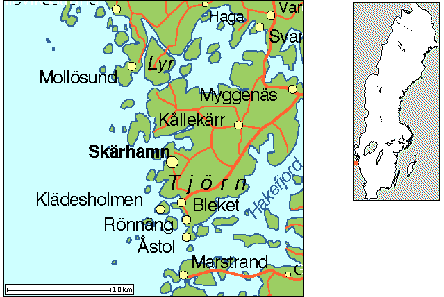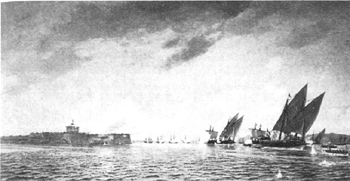
Marstrand
Marstrand
Marstrand of today is a small town in Kungälv municipality bulging in summer with its 10 000 visitors a week in high season. The resort tradition dates back to the early 19th century when it blossomed under the patronage of King Oscar II. People come for the sea - yachting, fishing, sea-kayaking, but also to visit the massive 17th century fortress, Carlsten, which dominates the city.

The location of Marstrand in the outer archipelago.
This intimate, and politically strategic, connection between the town and the sea that has always been characteristic of Marstrand has also been the source of strife between Denmark, Norway, the Hanseatic league and Sweden. The town has ever been a vital center for fishing, trade and warfare - the last of which now brings us archaeologists here.
History
According to the Norse Sagas Marstrand functioned as an anchorage already in the Viking Age and they also state that the settlement was founded in 1229 by King Hakon of Norway. Its location in the archipelago indicates a community living on herring fisheries and as an anchorage for all ships passing through the Skagerrak.
Sometime between 1277 and 1291 a Fransiscan monastery was founded on the island indicating the urban character of the settlement, as this order settled only in towns or major marketplaces. Marstrand's church also dates to the late 13th century and may actually be the church of the Blackfriars.
In 1368 the town suffered a major setback when the town, castle and church were razed by Dutch and German pirates. The town recovered quickly though and received its first preserved charter in the 15th century. It continued to prosper in the 16th century when the existence of a hospital and town-hall are indicated by historical sources, but the monastery was abandoned during the Reformation. Archaeological excavations indicate that it was during the 16th century the town received its current street-grid.
In 1658 the town was ceded to Sweden by Denmark-Norway as part of the Roskilde peace treaty and construction of the Carlsten fortress was begun on the orders of Carl X Gustavus. The fortress fell to the Norwegian commander Gyldenlöwe in 1677, but was returned to Sweden through the treaty of Versailles in 1679.
In the Great Northern War the town again became the scene of conflict, but remained in Swedish hands. During the 18th century the town boomed along with the herring fisheries and received porto franco status in 1775. During this period the town traded intensely with the fledgling United States of America and also received Sweden's first Jewish subjects.
The town lost both its special status and much of its trade in the last years of the century and was saved from receding into a minor fishing community by the patronage of King Oscar II. Since then Marstrand has lived on as a picturesque resort and fishing community.
The Great Northern War

Tordenskiold defeated at Gothenburg in 1717. In the background "Fredricus" can be seen firing at the retreating enemy.
In 1700 the Great Northern War began in which Sweden faced the coalition of Russia, Poland-Saxony , and Denmark-Norway. Initially the war went well for Sweden, but after the defeat at Poltava in 1709 Sweden came under increasing military and economic pressure, especially from the Danish and Russian fleets.
During the war Swedish naval forces on the west coast were based in Gothenburg, but many convoys with their escort departed from Marstrand and so the town was attacked in 1719 by the Danish-Norwegian sea-hero Tordenskiold. By then the Swedish navy was badly manned and equipped and morale was low due to the recent death of king Charles XII. The ships in Marstrand were not able to stop Tordenskiold from landing artillery batteries on the islands surrounding the town, nor to stop his naval bombardment. As the siege proceeded a number of Swedish ships were captured or sunk. The decision was made to scuttle the fleet and retreat into the town citadel Karlsten, which was widely considered as impregnable.
Five frigates ("Charlotta", "Kalmar", "Halmstad", "Stettin" and "Fredricius"), two galleys ("Ståbra" and "Greve Mörner") , one yacht ("Diana") and two fireships were scuttled and later depicted on a Danish chart showing Marstrand harbour. "Ståbra", "Greve Mörner" and "Charlotta" were subsequently raised, but the frigates still remain at the bottom of the harbour. The citadel was given over to the Danes in exchange for the free departure of its garrison - later the commander of the garrison was executed for his poor efforts in defending the town.
 Back to Nordic Underwater Archaeology
Back to Nordic Underwater Archaeology